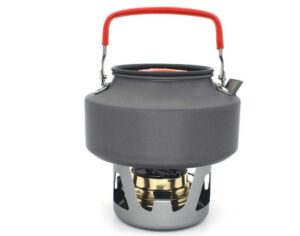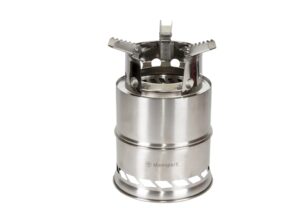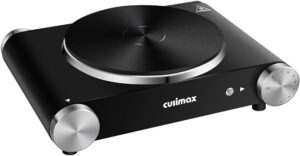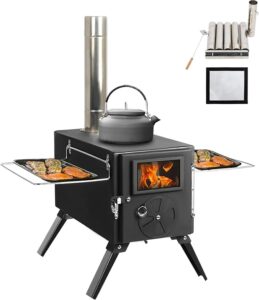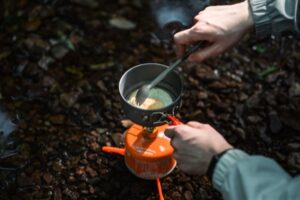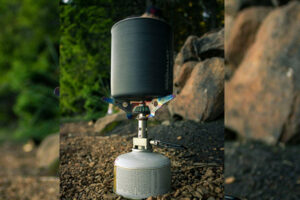Is It Safe to Use Camping Stoves Indoors?
Camping stoves are essential gear for outdoor adventures, providing a convenient cooking solution. While tempting to use indoors for emergencies or convenience, these devices pose significant risks, including carbon monoxide poisoning and fire hazards. Safety should always be prioritized when considering indoor use.
According to experts, small canister stoves can be used indoors for up to 30 minutes safely, given proper ventilation. However, indoor use overnight or for longer periods carries considerable risk.
The National Park Service advises to never use camping stoves inside tents or sheltered spaces due to carbon monoxide danger. Store rooms should be treated with similar caution. At the end of the day, any indoor use poses some degree of risk and the stove should not be left unattended.
Setting Up Your Camping Stove Indoors
Once you’ve selected an appropriate portable canister stove, it’s time to set it up for safe operation inside. Here are some top tips:
- Place on a sturdy and level surface in a clear area away from any flammable objects or materials. This includes curtains, paper, furniture, etc. which could ignite.
- Ensure the room has adequate ventilation. Open windows and doors fully, or use fans, to allow gases like carbon monoxide to escape. Consider setting up near patio doors for maximum ventilation.
- Keep a fire extinguisher and smoke detector nearby in case of emergencies. Check they are charged and functional.
- Carefully follow manufacturer guidelines for the safe use of your camping stove model indoors. Never override safety warnings.
- Start by operating the stove on low heat settings to get a sense of power output and ventilation needs, before moving to higher settings if required.
Step-by-Step Guide to Using A Camping Stove Indoors
While indoor use is not completely without risks, camping stoves can be utilized inside for brief periods by following these precautions:
- Select a portable canister stove suitable for indoor use, preferably under a 7,650 BTU rating.
- Set up in a well-ventilated room near windows or doors. Keep 3 feet minimum distance from walls or flammable objects.
- Operate initially on low heat to identify any issues before increasing heat.
- Keep a fire extinguisher or large container of water close by in case of fire.
- Check carbon monoxide detector is present and functional. Monitor CO levels frequently.
- Never leave the stove unattended, even briefly. Stay in the room to supervise.
- Use for as short a time period as possible, avoiding overnight operation.
- Allow the room to fully ventilate after use before occupying again.
While indoor use can be convenient, limit use to only essential situations. Taking proper safety steps is crucial.
Safety Precautions for Indoor Camping Stove Use
Using a camping stove indoors requires extreme caution due to inherent safety risks. Here are some essential precautions:
- Ventilation: Ensure adequate ventilation to prevent the buildup of harmful gases like carbon monoxide.
- Fire Safety: Keep the stove away from flammable materials such as curtains, paper, and fabrics.
- Stable Surface: Place the stove on a stable, non-flammable surface.
- Suitable Environment: Avoid using the stove in bedrooms, enclosed spaces, or areas with poor ventilation.
- Adult Supervision: Keep children away from the stove and prevent them from operating it.
- Follow Instructions: Carefully read and follow the manufacturer’s instructions.
- Fuel Safety: Use the recommended fuel and store it safely.
- Turn Off and Cool: Ensure the stove is turned off and completely cooled before touching.
- Emergency Preparedness: Have a fire extinguisher or fire blanket readily available and know how to use it.
- Limited Use: Avoid prolonged indoor use of the camping stove.
- Regular Inspection: Regularly inspect the stove for any damage or wear.
- Professional Advice: Consult a professional if you are unsure about safety measures.
- Local Regulations: Familiarize yourself with local laws and regulations regarding indoor open flames.
Indoor use of camping stoves is generally not recommended except in emergency situations or with specialized indoor camping equipment and conditions. Whenever possible, use camping stoves outdoors.
Which Camping Stoves are Best for Indoor Use?
When considering which camping stove to use indoors, several factors come into play. Here are some types of stoves that might be suitable:
Alcohol stoves: These produce fewer harmful gases during combustion, making them a relatively safer option for indoor use. However, adequate ventilation remains essential.
Recommended Products:Keweis Portable Outdoor Mini Alcohol Stove
Lightweight: Net weight 145g/5oz, base size: 3.86 x 3.86 x 2.29 inches.
Material: Aluminum alloy stove frame and brass stove with windproof function.
Leakproof: The rubber ring on the stove cover is completely sealed to prevent alcohol leakage and evaporation.
Variable temperature control: The flame regulator can control the flame and comes with a foldable handle.
Efficient: The surrounding burning holes increase air ventilation, high combustion efficiency, and the fire lasts about 50 minutes/100 ml of alcohol.
Wood-burning stoves: Some wood-burning stoves are designed with flue connections, allowing them to be installed indoors and vent smoke outdoors through a chimney.
Recommended Products:Small Stainless Steel Wood Burning Stove
Durable stainless steel construction
Compact design folds for easy storage
Burns wood chips and branches, no gas or liquid fuel required
Setup dimensions: 5.5″ x 5.5″ x 8″
8″L x 5.5″W x 5.5″H
Great for backpacking, camping, and more!
Pellet stoves: Using compressed wood pellets as fuel, pellet stoves provide sustained heat and are suitable for indoor use, but require a proper exhaust system.
Electric stoves: As they don’t involve combustion, electric stoves produce no harmful gases and are a safe choice for indoor use.
Recommended Products:CUSIMAX Electric Hot Plate
Suitable for all cookware: Compatible with pots and pans up to 7.1 inches in size, glass and aluminum, all can be heated.
7 thermostatic controls: The hot plate uses 7 thermostatically controlled heating settings, which is convenient for cooking a variety of foods, such as warming sauces, frying steaks, grilling cheese, boiling water, making soups, cooking pasta and vegetables, etc.
Compact and portable: Small size, easy to carry, no stove required.
Safe and durable: Durable cast iron stove with automatic safety shut-off function, temperature regulated by thermostat.
Indoor-safe certified stoves: Some stoves may be labeled as “safe for indoor use” or have similar certifications. These stoves are designed with specific safety features for indoor environments.
Portable wood-burning stoves: Certain portable wood-burning stoves have built-in exhaust systems, allowing for safe indoor use, but ventilation should still be a priority.
Recommended Products:Outdoor Portable Wood Burning Stove
Portable: With folding racks on both sides, 15.4lbs. The chimney pipe can be easily stored in the stove, and the hooks included with the wood stove can easily clean the ashes at the bottom.
Durable: The top of the stove can be removed with a gutter, and the camping stove hole can provide enough heat, you can boil water for coffee, cook or enjoy barbecue.
Heat Output Regulator: One of the chimney pipes is equipped with a damping tool to manage the flame and burning rate. The rotation of a small fan under the glass helps to adjust the heat output.
High Flame Retardant Upgrade: 7 chimney pipes with a diameter of 2.36 inches/6 cm, the height can be adjusted to fit a variety of places. Can be used in bell tents with stove pipe vents.
Infrared heaters: Using electricity, infrared heaters produce less thermal radiation and are suitable for indoor cooking and heating.
Choosing the Right Camping Stove for Indoor Use
Not all camping stoves are created equal when it comes to indoor operation. More powerful stove models designed for group camping may produce excessive heat and carbon monoxide in enclosed spaces. Instead, opt for smaller backpacking-style canister stoves that connect to compact propane fuel tanks. These provide sufficient heating power for limited indoor tasks, while still being safe when proper precautions are taken.
Look for low BTU ratings and low-profile designs made for portability. Outdoor enthusiast forums suggest some lightweight canister stove models are excellent choices for cautious indoor use thanks to their burner design. Larger full-size camping stoves are best avoided for indoor use.
When choosing a camping stove for indoor use, consider the following factors:
- Safety features: Look for stoves with safety valves, fuel leak prevention systems, and flame failure safety devices.
- Fuel type: Choose fuels that burn cleanly and produce minimal emissions.
- Ventilation: Ensure adequate ventilation to prevent the buildup of harmful gases.
- Exhaust system: If using wood or pellet-burning stoves, ensure there is a proper exhaust and chimney system.
- Portability: Indoor stoves may need to be easily moved and stored.
- Local regulations: Familiarize yourself with local laws and regulations regarding indoor open flames.
Where to Buy a Camping Stove for Indoor Use
When selecting a camping stove for occasional indoor use, reputable outdoor retailers have quality options available both in-store and online. Look for recognized backpacking stove brands.
Consider safety features like automatic shut-off valves if knockover occurs. Also, be sure to purchase recommended fuel canisters designed for your stove model. Follow all operating instructions carefully for reliable and safe indoor performance.
In summary, small portable canister camping stoves can be used indoors for brief periods when necessary, but require strict adherence to ventilation and fire safety guidelines. With prudent precautions, they can provide temporary supplemental heat and cooking sources. But exercise extreme caution and always put safety first. Never leave a stove unattended indoors.


